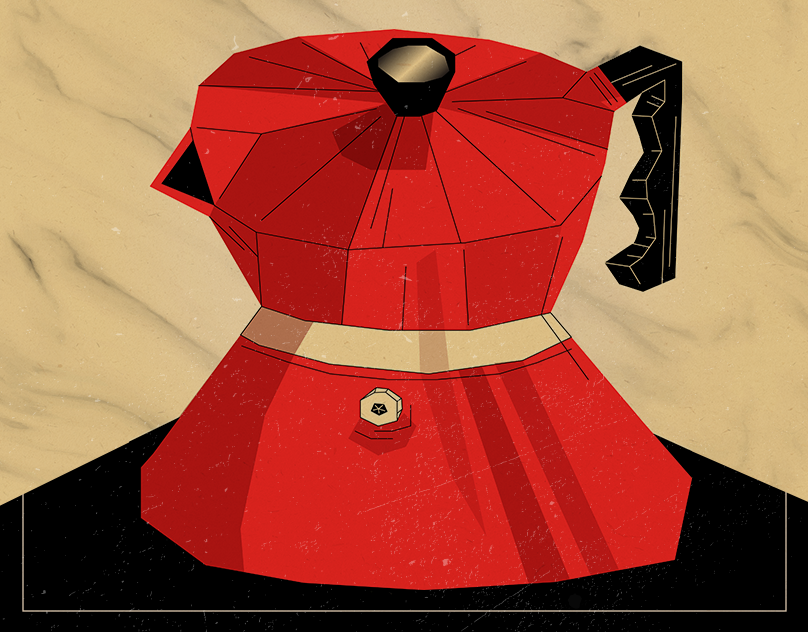Ask an (IGI) Illustrator No 3: Rachel Corcoran
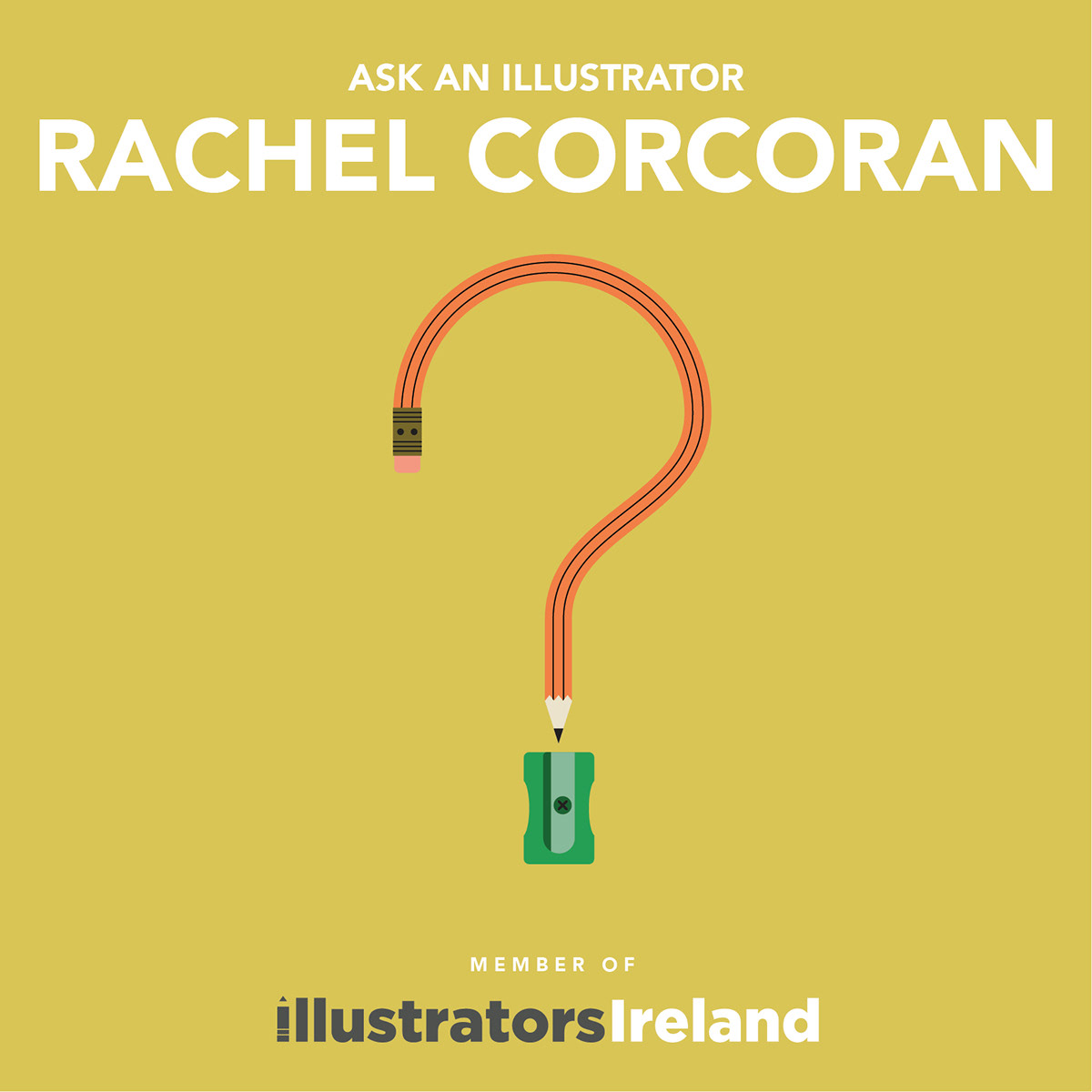
Q: Tell us a little about yourself?
A: I was born (and still live) in south Dublin. I’ve lived here all my life. I love the proximity to the city center, while still being far enough away from it to enjoy the mountains and countryside of Dublin. I originally studied History of Art and Archaeology at UCD, achieving a Masters degree. However, with the recession in full force, I decided to explore my artistic interests (art was just a hobby but a big part of my life) and return to college to study Graphic Design in Ballyfermot College of Further Education. The course was exceptional, and I learned so much about myself as a creative. I fell in love with illustration (which was a separate module) and slowly began to investigate it even further when I graduated. I always loved illustrated books when I was younger, but I never realised a career could be made from it. It’s one of those subjects I wish I had known about when filling out my CAO form all those years ago!
A: I was born (and still live) in south Dublin. I’ve lived here all my life. I love the proximity to the city center, while still being far enough away from it to enjoy the mountains and countryside of Dublin. I originally studied History of Art and Archaeology at UCD, achieving a Masters degree. However, with the recession in full force, I decided to explore my artistic interests (art was just a hobby but a big part of my life) and return to college to study Graphic Design in Ballyfermot College of Further Education. The course was exceptional, and I learned so much about myself as a creative. I fell in love with illustration (which was a separate module) and slowly began to investigate it even further when I graduated. I always loved illustrated books when I was younger, but I never realised a career could be made from it. It’s one of those subjects I wish I had known about when filling out my CAO form all those years ago!

Q: Why did you become an illustrator?
A: To create original images all day is what I love to do most. I am a very visual person, and often find it easier to think ‘in pictures,’ and it’s something that comes quite naturally to me. I love to share these images with an audience who appreciates and understands them. I always wanted a career that was fulfilling, creative, challenging and fun - and illustration brings all of these aspects to the table.
A: To create original images all day is what I love to do most. I am a very visual person, and often find it easier to think ‘in pictures,’ and it’s something that comes quite naturally to me. I love to share these images with an audience who appreciates and understands them. I always wanted a career that was fulfilling, creative, challenging and fun - and illustration brings all of these aspects to the table.
Q: How has your upbringing/environment influenced or shaped your illustration?
A: I’ve always been a daydreamer with a wild imagination. My illustrations are definitely inspired by this. I imagine and illustrate alternative worlds and lives, and also delve into my own childhood memories, such as the building of an imaginary space rocket or pirate ship from household furniture and belongings - I love the endless possibilities that a personal experience can have on an illustration. My family encouraged play and artistic pursuits from a very young age, and this freedom and acceptance gave me the confidence to choose a creative career. My two siblings also work in the creative industries (Graham and Gillian), and the support of our parents is of huge importance to us.
A: I’ve always been a daydreamer with a wild imagination. My illustrations are definitely inspired by this. I imagine and illustrate alternative worlds and lives, and also delve into my own childhood memories, such as the building of an imaginary space rocket or pirate ship from household furniture and belongings - I love the endless possibilities that a personal experience can have on an illustration. My family encouraged play and artistic pursuits from a very young age, and this freedom and acceptance gave me the confidence to choose a creative career. My two siblings also work in the creative industries (Graham and Gillian), and the support of our parents is of huge importance to us.
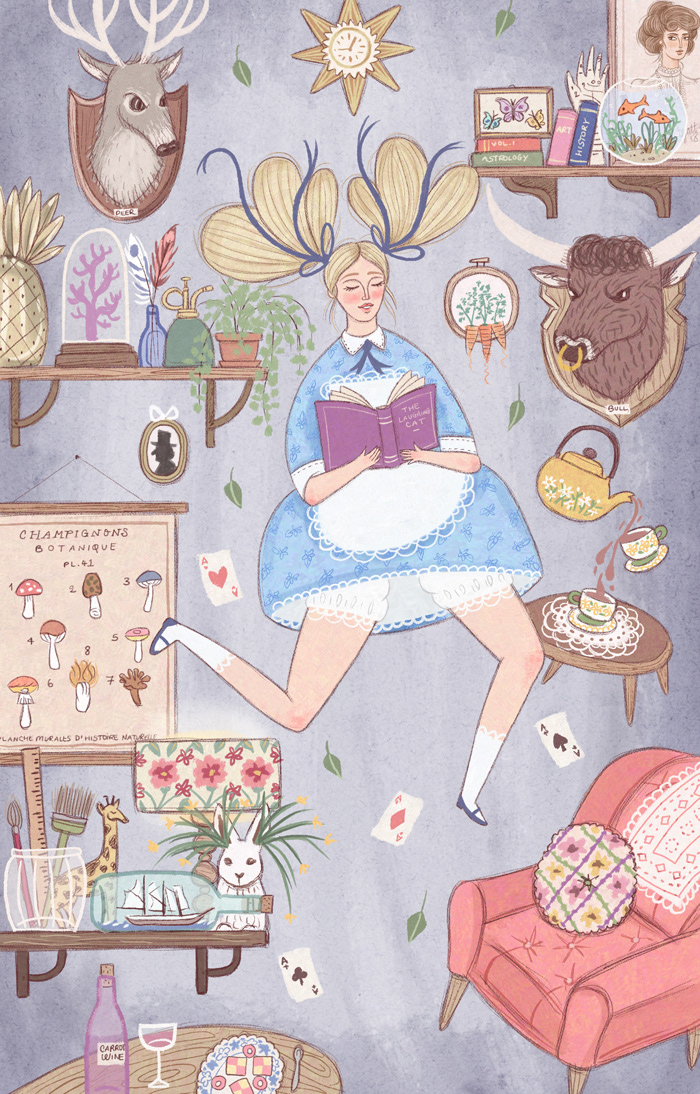
Q: What do you like to draw the most?
A: I love drawing human figures – sketching different characters and their quirky fashions. I’ve been drawing more scenes and backgrounds lately also, and I’m having fun exploring the details of a scene, especially outdoor scenes with lots of flowers, greenery and curious hidden elements.
A: I love drawing human figures – sketching different characters and their quirky fashions. I’ve been drawing more scenes and backgrounds lately also, and I’m having fun exploring the details of a scene, especially outdoor scenes with lots of flowers, greenery and curious hidden elements.
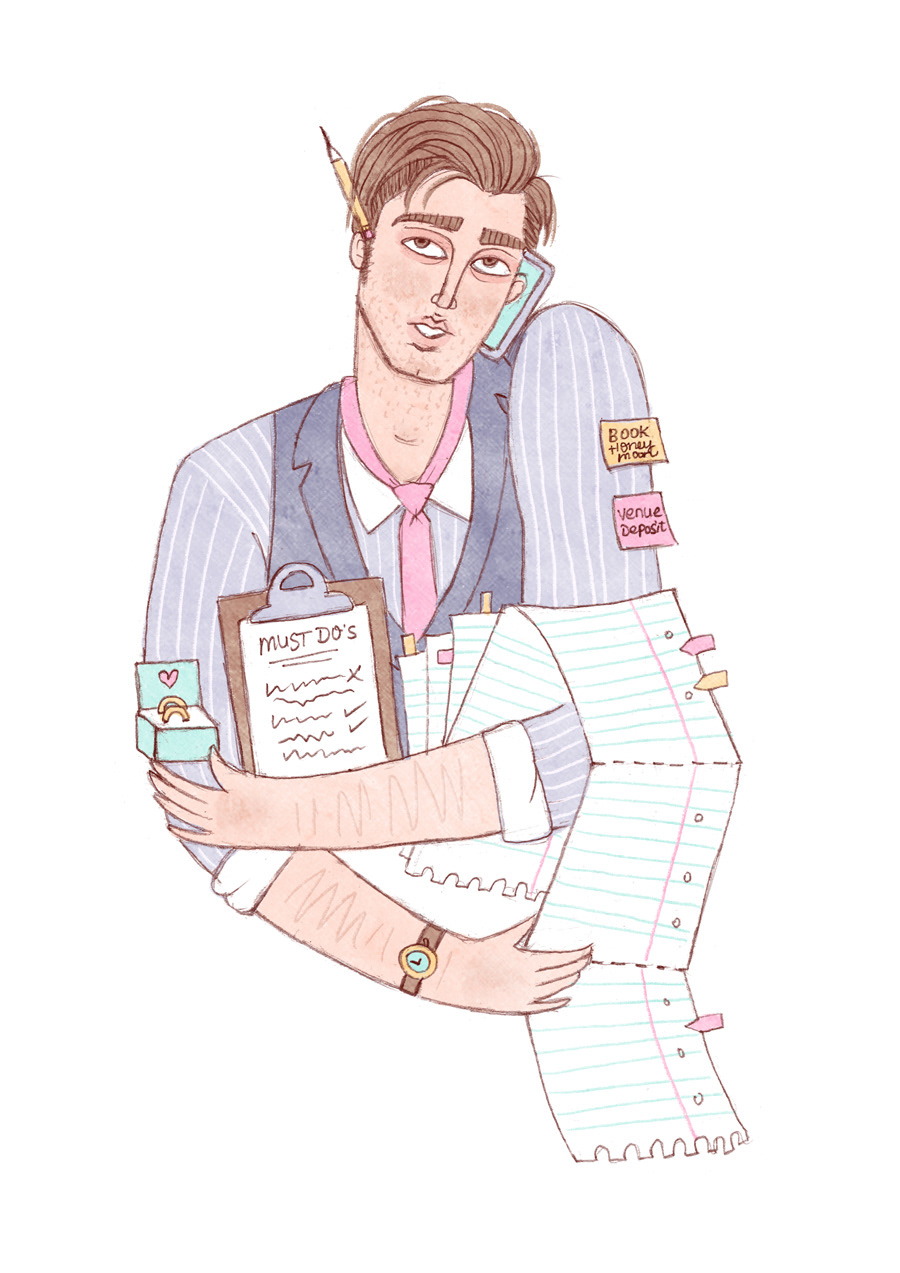
Q: What is your best tip for staying organised?
A: I’m a list-maker, and I would be lost without either a list sitting next to my computer, or a digital list made on my phone. Any idea that pops into my head, I write it down. Anything with a tight deadline makes its way to the top of the list. Always prioritise your work. This may mean working on several projects during the day, and allowing a couple of hours for each. At least you’re chipping away at each project rather than leaving it all in one block. It can be easy to get bored with a project if you’re working on it for one whole day, so divide your workload and make things more interesting. Add some personal projects in to the mix, and your work day will be varied, more exciting, and productive.
A: I’m a list-maker, and I would be lost without either a list sitting next to my computer, or a digital list made on my phone. Any idea that pops into my head, I write it down. Anything with a tight deadline makes its way to the top of the list. Always prioritise your work. This may mean working on several projects during the day, and allowing a couple of hours for each. At least you’re chipping away at each project rather than leaving it all in one block. It can be easy to get bored with a project if you’re working on it for one whole day, so divide your workload and make things more interesting. Add some personal projects in to the mix, and your work day will be varied, more exciting, and productive.
Q: What tools do you use?
A: I always begin with a pencil sketch on paper, and usually move on to my Wacom Cintiq for digital drawing and colouring. I use Photoshop, and digital pencil and paint brushes.
A: I always begin with a pencil sketch on paper, and usually move on to my Wacom Cintiq for digital drawing and colouring. I use Photoshop, and digital pencil and paint brushes.
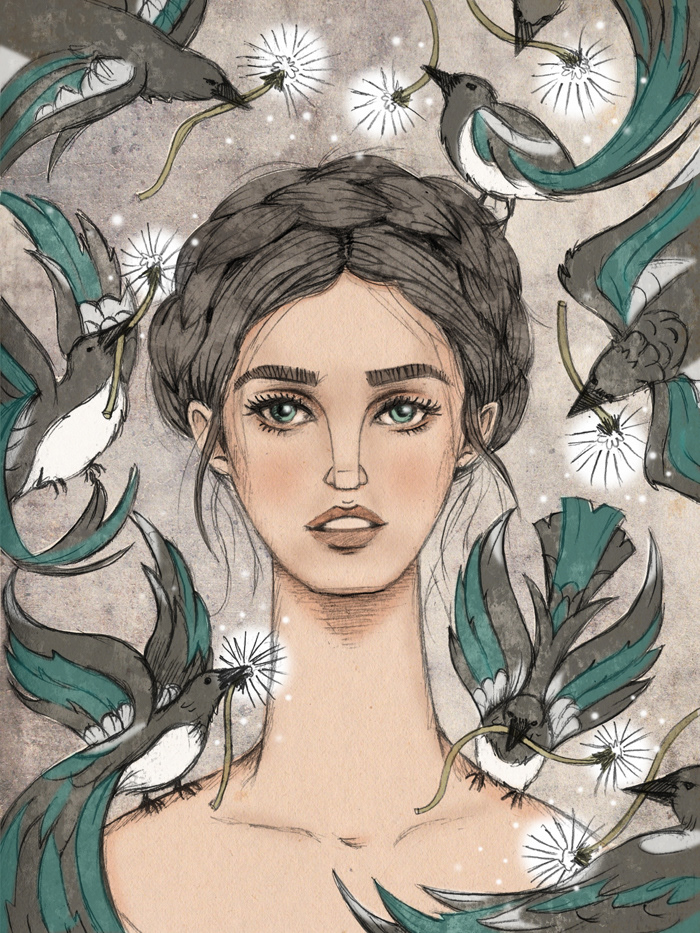
Q: What was your first ever commissioned illustration?
A: It was a series of horoscope fashion illustrations for Kiss Magazine (an Irish teenage magazine). It consisted of several pages in total, and I illustrated each zodiac sign as a fashionable female. For example, Gemini was illustrated as a pair of pin-up twins - one from LA, one from NY. It was a proud moment to see my illustrations in a publication – there’s always something extra special about seeing my work in print.
A: It was a series of horoscope fashion illustrations for Kiss Magazine (an Irish teenage magazine). It consisted of several pages in total, and I illustrated each zodiac sign as a fashionable female. For example, Gemini was illustrated as a pair of pin-up twins - one from LA, one from NY. It was a proud moment to see my illustrations in a publication – there’s always something extra special about seeing my work in print.
Q: What are three things you’ve learned while working as an illustrator?
1. Accounting and business management - not my strong suit, but an important aspect to the job.
2. Don’t overwork yourself – it’s ok to not think creatively every day and to give the mind a rest.
3. Always use a licensing contract. Contracts can be tricky to negotiate, but I’ve learned how integral they are to working as a professional (and headache-free) illustrator!
1. Accounting and business management - not my strong suit, but an important aspect to the job.
2. Don’t overwork yourself – it’s ok to not think creatively every day and to give the mind a rest.
3. Always use a licensing contract. Contracts can be tricky to negotiate, but I’ve learned how integral they are to working as a professional (and headache-free) illustrator!

Q: How do you find time for personal projects?
A: It depends on my working schedule each week. When I have some quiet time in between client projects, I’ll use this opportunity in a positive way and work on the long list of personal projects I hope to one day fully complete. I keep adding to this list constantly, and pick a few that I think would suit best for my portfolio and my online store. It’s best to keep a balance of both client and personal projects on the go, even if you can only manage an hour a day - it all adds up by the end of the week.
A: It depends on my working schedule each week. When I have some quiet time in between client projects, I’ll use this opportunity in a positive way and work on the long list of personal projects I hope to one day fully complete. I keep adding to this list constantly, and pick a few that I think would suit best for my portfolio and my online store. It’s best to keep a balance of both client and personal projects on the go, even if you can only manage an hour a day - it all adds up by the end of the week.
Q: What are you working on now?
A: I’ve just completed a new book cover illustration for The O’Brien Press and Judi Curtin, and I’ve also been working on several personal projects that take up a lot of my time, which involve both my online store and (fingers crossed) a picture book.
A: I’ve just completed a new book cover illustration for The O’Brien Press and Judi Curtin, and I’ve also been working on several personal projects that take up a lot of my time, which involve both my online store and (fingers crossed) a picture book.

Q: What does your creative process look like?
A: I’ll usually begin with visual research first. I have a research brain, so I can’t ignore this part of the process. Next, I’ll work on very rough small sketches. I find it easier to draw thumbnail sketches so it doesn’t feel too daunting at the beginning of the process. I also find working in a sketchbook to be a bit limiting, so I just choose a page from a stack of inexpensive paper on my desk. I’ll then pick one idea and develop it a little further on paper, but not too detailed. I tend nowadays to do my final sketching on my Wacom Cintiq. I use Photoshop for this. I like to use just a few digital brushes from a library of 100s! Sometimes limitation helps with the creative process! These brushes are often very traditional looking, such as watercolours or pencils, as I prefer a more hand-drawn aesthetic to my digital work. I’ll finalise the sketch on one layer, lock it, and then begin blocking in colour and adding line work. I’m quite indecisive with colour choices, so I find working digitally to be more preferable, so I can achieve a good colour harmony through trial and error and plenty of cmd+z!
A: I’ll usually begin with visual research first. I have a research brain, so I can’t ignore this part of the process. Next, I’ll work on very rough small sketches. I find it easier to draw thumbnail sketches so it doesn’t feel too daunting at the beginning of the process. I also find working in a sketchbook to be a bit limiting, so I just choose a page from a stack of inexpensive paper on my desk. I’ll then pick one idea and develop it a little further on paper, but not too detailed. I tend nowadays to do my final sketching on my Wacom Cintiq. I use Photoshop for this. I like to use just a few digital brushes from a library of 100s! Sometimes limitation helps with the creative process! These brushes are often very traditional looking, such as watercolours or pencils, as I prefer a more hand-drawn aesthetic to my digital work. I’ll finalise the sketch on one layer, lock it, and then begin blocking in colour and adding line work. I’m quite indecisive with colour choices, so I find working digitally to be more preferable, so I can achieve a good colour harmony through trial and error and plenty of cmd+z!

Q: What area of illustration do you specialise in/enjoy?
A: I like to work on a range of projects as it offers variety to the job. I enjoy pretty much most aspects of illustration, be it fashion illustration, illustrating chocolates for a food producer, or illustrating book covers. My main passion, however, is book illustration as I love exploring the personalities and faces of characters, and the settings they live in.
A: I like to work on a range of projects as it offers variety to the job. I enjoy pretty much most aspects of illustration, be it fashion illustration, illustrating chocolates for a food producer, or illustrating book covers. My main passion, however, is book illustration as I love exploring the personalities and faces of characters, and the settings they live in.

Q: What would be your dream (illustration) job/commission?
A: A fully illustrated picture book for one of the big publishing houses. I’m not too picky!
A: A fully illustrated picture book for one of the big publishing houses. I’m not too picky!

Q: How does your studio/workplace look like?
A: It’s a small (but cosy!) space, and it suits me well, as I mostly illustrate digitally and don’t need too much space. I have a desk for my computer and drawing tablet - this is where I sit mostly. And I have another desk opposite for packing-up any shop orders, wholesale orders, and when I’m painting, drawing or crafting. My walls are covered (in an organised and neat manner) with a mixture of my own illustrations and those which inspire me. I have many drawers filled with lots of art materials for experimentation and any last minute craft projects I need to work on. Some of these materials have been with me since I was about 11 years old - I hate to throw them out, they have such vivid memories for me from my past artistic endeavors!
A: It’s a small (but cosy!) space, and it suits me well, as I mostly illustrate digitally and don’t need too much space. I have a desk for my computer and drawing tablet - this is where I sit mostly. And I have another desk opposite for packing-up any shop orders, wholesale orders, and when I’m painting, drawing or crafting. My walls are covered (in an organised and neat manner) with a mixture of my own illustrations and those which inspire me. I have many drawers filled with lots of art materials for experimentation and any last minute craft projects I need to work on. Some of these materials have been with me since I was about 11 years old - I hate to throw them out, they have such vivid memories for me from my past artistic endeavors!
Q: Where do you find inspiration?
A: From various interests, such as a book I may be reading, or a particular historical period I have an interest in. I love collecting old vintage objects, nostalgia and ephemera, so these really inspire me too - and the stories they may carry with them. I also love walking and wandering through forests and mountains - the natural surroundings are probably where I find my greatest inspiration.
A: From various interests, such as a book I may be reading, or a particular historical period I have an interest in. I love collecting old vintage objects, nostalgia and ephemera, so these really inspire me too - and the stories they may carry with them. I also love walking and wandering through forests and mountains - the natural surroundings are probably where I find my greatest inspiration.

Q: How do I go about commissioning you as an illustrator?
A: Easy, just send me an email to rachillustrates@gmail.com with your project brief, and we can discuss your requirements over a digital coffee.
A: Easy, just send me an email to rachillustrates@gmail.com with your project brief, and we can discuss your requirements over a digital coffee.
Portfolio: www.rachelcorcoran.net
and www.IllustratorsIreland.com/rachelcorcoran
Instagram: @rachelcorcoranillustration
Twitter: @artbyrach
Pinterest: @rachelcorcoran
Instagram: @rachelcorcoranillustration
Twitter: @artbyrach
Pinterest: @rachelcorcoran



